Article catalog
1 Overview
- In order to recover Oracle database from misoperation quickly, Oracle has introduced flashback technology.
- This blog mainly shares the flashback query, flashback transaction query, flashback version query, flashback table and flashback deletion in the flashback technology. For the Flashback Database and flashback file, the impact range is too wide and it is generally not recommended to use.
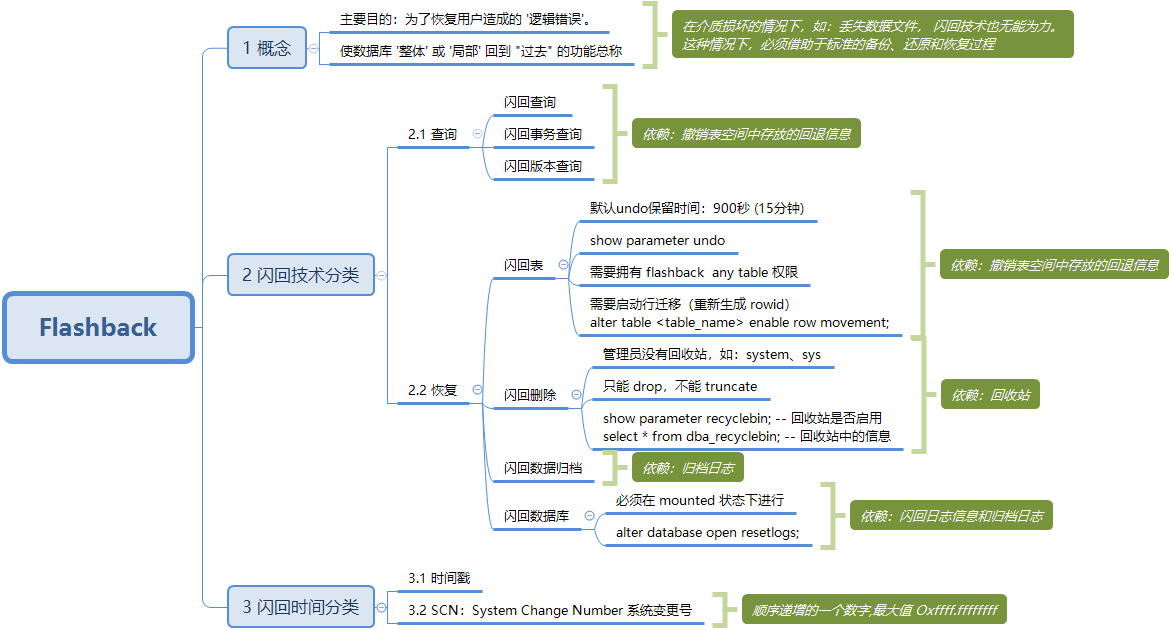
Query current system timestamp and SCN
SELECT to_char(SYSDATE, 'YYYY-MM-HH hh24:mi:ss:mm') timestamp,
timestamp_to_scn(SYSDATE) scn
FROM dual;
2 example description
2.1 flashback query
- Function: query the data before a certain time in the past
- Note: commit time
Syntax:
select *
from table_name
[as of timestamp | scn expression]
[where condition]
Basic data: insert 3 records and flash back query
CREATE TABLE flashback_select_test ( ID NUMBER, NAME VARCHAR2(30), create_date DATE, create_scn NUMBER ); -- Set the time format for easy viewing ALTER SESSION SET nls_date_format = 'YYYY/MM/DD HH24:MI:SS'; -- insert Statement, the execution interval is a few seconds, which is convenient for testing INSERT INTO flashback_select_test (id, NAME, create_date, create_scn) VALUES (1, 'a', SYSDATE, timestamp_to_scn(SYSDATE)); COMMIT; INSERT INTO flashback_select_test (id, NAME, create_date, create_scn) VALUES (2, 'b', SYSDATE, timestamp_to_scn(SYSDATE)); COMMIT; INSERT INTO flashback_select_test (id, NAME, create_date, create_scn) VALUES (3, 'c', SYSDATE, timestamp_to_scn(SYSDATE)); COMMIT;
Data validation:
SELECT * FROM flashback_select_test;
SELECT * FROM flashback_select_test AS OF TIMESTAMP to_timestamp('2020/8/3 22:21:04', 'YYYY/MM/DD HH24:MI:SS');
SELECT * FROM flashback_select_test AS OF SCN 12614250;
Query screenshot:
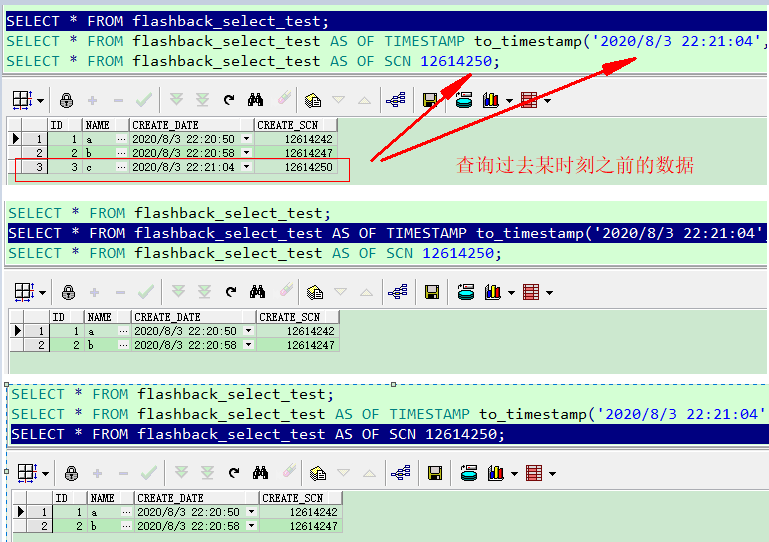
2.2 flashback version query
- When recording changes, the commit time happens to be recorded, which can be queried by flashing back (generally, we don't specifically record this time)
- If it is not recorded, use the flashback version to query
- Function: you can query all submitted records
Syntax:
select *
from table_name
versions between scn expr | timestamp minvalue
and expr | maxvalue [as of scn | timestamp expr];
1. between ... and: time slot
2. scn | timestamp: Time format(System change number | time stamp)
3. minvalue | maxvalue: Time value(minimum value | Maximum)
4. Available pseudo columns
(1) versions_starttime : Lower bound of valid range of version based on time
(2) versions_startscn : be based on SCN Lower bound of valid range of version
(3) versions_endtime : Upper bound of time-based version valid range
(4) versions_endscn : be based on SCN Upper bound of valid range of version
(5) versions_xid : Operational transactions ID
(6) versions_operation : Type of operation performed. I: insert,U: delete,D: DELETE
Demonstration: (when the DML statement is executed, the interval is a few seconds for easy observation)
CREATE TABLE flashback_versions_test ( ID NUMBER, NAME VARCHAR2(30) ); -- The following statements are executed at intervals of several seconds for easy observation INSERT INTO flashback_versions_test(ID, NAME) VALUES(1, 'Yao Yao'); COMMIT; INSERT INTO flashback_versions_test(ID, NAME) VALUES(2, 'pleasing'); COMMIT; UPDATE flashback_versions_test t SET t.name = 'Qianqian 123' WHERE t.id = 2; COMMIT; INSERT INTO flashback_versions_test(ID, NAME) VALUES(3, 'gentle'); COMMIT;
Flashback version query statement:
SELECT id,
NAME,
to_char(versions_starttime, 'YYYY-MM-DD HH24:MI:SS') versions_starttime,
to_char(versions_endtime, 'YYYY-MM-DD HH24:MI:SS') versions_endtime,
versions_startscn,
versions_endscn,
versions_xid,
versions_operation
FROM flashback_versions_test versions BETWEEN TIMESTAMP minvalue AND maxvalue
ORDER BY versions_starttime;
Query results:

2.3 flashback transaction query
- Flashback transaction query is actually an extension of flashback version query, which can audit a transaction or even revoke a committed transaction.
Prerequisite knowledge:
SELECT t.* FROM flashback_transaction_query t WHERE t.logon_user = 'SYSTEM'; -- The user you are logged in to -- GRANT SELECT ANY TRANSACTION TO scott; -- Test the user. If the permission is insufficient, authorization is required -- Add supplemental log (If not undo_sql Empty) SELECT t.supplemental_log_data_min, t.* FROM v$database t; -- YSE: open ALTER DATABASE ADD SUPPLEMENTAL LOG DATA; -- Open statement
Basic data preparation: suppose you forget to bring the where condition when updating
CREATE TABLE flashback_transaction_query_ts ( ID NUMBER, NAME VARCHAR2(30), create_date DATE ); -- insert Statement, with an interval of a few seconds for easy observation INSERT INTO flashback_transaction_query_ts (id, NAME, create_date) VALUES (1, 'Little wanderer', SYSDATE); COMMIT; INSERT INTO flashback_transaction_query_ts (id, NAME, create_date) VALUES (2, 'Xiaoyouzi', SYSDATE); COMMIT; INSERT INTO flashback_transaction_query_ts (id, NAME, create_date) VALUES (3, 'Xiaoqianzi', SYSDATE); COMMIT; -- Suppose I wanted to update it id = 2 Record the result and forget to write the condition where id = 2 UPDATE flashback_transaction_query_ts t SET t.name = 'Xiaoyouzi 22'; COMMIT;
Data validation:
1. First, use the flashback version query to query the transaction id
SELECT id,
NAME,
to_char(versions_starttime, 'YYYY-MM-DD HH24:MI:SS') versions_starttime,
to_char(versions_endtime, 'YYYY-MM-DD HH24:MI:SS') versions_endtime,
versions_startscn,
versions_endscn,
versions_xid,
versions_operation
FROM flashback_transaction_query_ts versions BETWEEN TIMESTAMP minvalue AND maxvalue
ORDER BY versions_starttime;
2. According to transaction id,obtain undo_sql
SELECT t.*
FROM flashback_transaction_query t
WHERE t.logon_user = 'SYSTEM'
AND t.xid = '08001C00AB1F0000';
Test results:
-- undo_sql Copy as follows: 1 update "SYSTEM"."FLASHBACK_TRANSACTION_QUERY_TS" set "NAME" = 'Xiaoqianzi' where ROWID = 'AAAVUzAABAAAVxpAAC'; 2 update "SYSTEM"."FLASHBACK_TRANSACTION_QUERY_TS" set "NAME" = 'Xiaoyouzi' where ROWID = 'AAAVUzAABAAAVxpAAB'; 3 update "SYSTEM"."FLASHBACK_TRANSACTION_QUERY_TS" set "NAME" = 'Little wanderer' where ROWID = 'AAAVUzAABAAAVxpAAA';
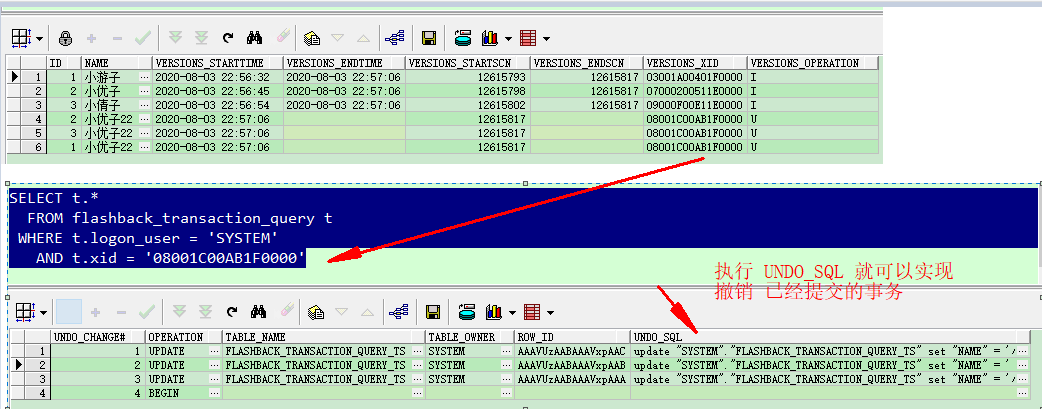
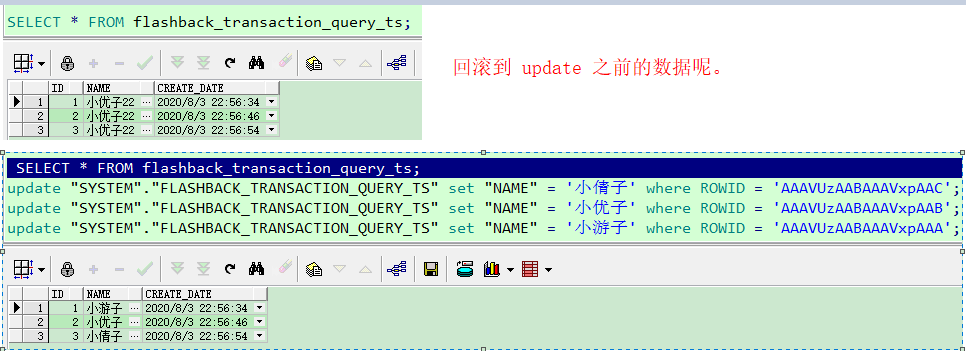
2.4 flashback table
- Restore the amount data deleted by delete
- Row migration needs to be enabled
- Note undo_retention time in retention
Basic data:
CREATE TABLE flashback_table_test ( ID NUMBER, NAME VARCHAR2(30) ); INSERT INTO flashback_table_test (ID, NAME) VALUES(1, 'Yao Yao'); INSERT INTO flashback_table_test (ID, NAME) VALUES(2, 'pleasing'); INSERT INTO flashback_table_test (ID, NAME) VALUES(3, 'gentle'); COMMIT;
Flashback table Demo:
-- Query first
SELECT t.*, ROWID FROM flashback_table_test t;
SELECT to_char(SYSDATE, 'YYYY-MM-HH hh24:mi:ss:mm') time,
timestamp_to_scn(SYSDATE) scn
FROM dual;
-- Delete again DELETE FROM flashback_table_test t WHERE t.id = 2; COMMIT; -- Flashback command start ALTER TABLE flashback_table_test ENABLE ROW MOVEMENT; -- Open table row movement(Regenerate rowid) FLASHBACK TABLE flashback_table_test TO SCN 12442453; -- Flashback command end SELECT t.*, ROWID FROM flashback_table_test t;
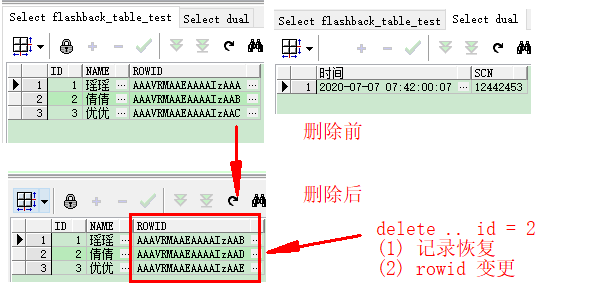
2.5 flashback deletion
- Can restore: tables deleted using drop
- Cannot restore: tables under the administrator user (such as system, sys) or truncate d tables
Syntax:
FLASHBACK TABLE table_name TO BEFORE DROP [RENAME TO table_name2] -- Delete the table and modify the table name at the same time [ENABLE|DISABLE] triggers; -- Enable while deleting the table|Disable trigger
Basic data preparation:
CREATE TABLE scott.flashback_drop_test ( ID NUMBER, NAME VARCHAR2(30) ); SELECT * FROM scott.flashback_drop_test; DROP TABLE scott.flashback_drop_test;
Case 1: General flashback
SELECT * FROM dba_recyclebin t WHERE t.owner = 'SCOTT'; -- or user_recyclebin FLASHBACK TABLE scott.flashback_drop_test TO BEFORE DROP;
Case 2: the table name in the recycle bin already exists in the database (duplicate name):
- Solution: Rename
SELECT * FROM dba_recyclebin t WHERE t.owner = 'SCOTT' ORDER BY t.droptime DESC; -- or user_recyclebin Mode 1: FLASHBACK TABLE scott.flashback_drop_test TO BEFORE DROP RENAME TO flashback_drop_test2; Mode 2: (recommended, prevented) "A table can be deleted multiple times" (in case of) -- SELECT * FROM scott."BIN$hr4mmwLmTAyvSvOcqvFO+A==$0"; FLASHBACK TABLE scott."BIN$hr4mmwLmTAyvSvOcqvFO+A==$0" TO BEFORE DROP RENAME TO flashback_drop_test3;

Case 3: one table is deleted multiple times
- Please note: the last deleted table is restored
Basic data preparation:
CREATE TABLE scott.flashback_drop_test ( ID NUMBER, NAME VARCHAR2(30) ); DROP TABLE scott.flashback_drop_test; -- The above creation and deletion operations shall be performed at least twice to facilitate demonstration SELECT * FROM user_recyclebin t ORDER BY t.droptime DESC;
demonstration:
FLASHBACK TABLE flashback_drop_test TO BEFORE DROP;

3 expansion
1. Show recycle bin( sqlplus (command) > show recyclebin 2. Empty recycle bin( sqlplus (command) > purge recyclebin 3. Query recycle bin select * from dba_recyclebin; -- user_recyclebin 4. Delete table and empty in Recycle Bin drop table table_name purge; 5. Empty the table data and empty it in the recycle bin truncate table table_name;